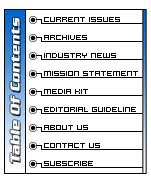|
Oblivision . . . A Lateral Imaging Technique
Joseph Freund
Imagine that you are an intelligence officer charged with mission
planning for a rescue operation, hostage situation, preemptive
strike, or special-forces combat mission. You would probably
use an orthophoto to obtain a “straight-down” view of every
point on the terrain.
Figure 1 shows the proposed route of a task force from point
T1 to point P1 and, from there, to points B1 and T2. The route
looks easy enough—the force will approach the main road, cross
it, proceed through the bush to the dirt road on the other side,
and continue on to the destination.
In reality, however, the situation is quite different. Along
the main road, at point P1, lies a concrete wall that is 3.5
meters tall and is totally invisible on the orthophoto, even
at high magnification. Furthermore, the orthophoto gives no
indication of how tall the building is at point B1 and which
parts of the access route are visible from that building.
The wall is readily discernible on a regular aerial photograph
shot at an angle—an oblique photo—as can be seen in Figure 2.
But some of the buildings obstruct others in the oblique
photo, and it does not permit accurate measurement. Clearly,
an orthophoto is more appropriate for obtaining a general
impression rather than for gathering the details required for
mission planning.
A company in Israel, Idan Computers Ltd. (www.idan.com), has
created a solution for merging the types of data provided by
orthophotos and oblique photos into one comprehensive, interactive
tool—Oblivision. Figure 3 gives the Oblivision view of the terrain
seen in Figure 1.
In the background is the orthophoto. The photos in the
corners show the relevant areas of the oblique photo and provide
four views of point P1, each from a different direction. Each
of the corner photos has a colored spot (blue, green, red, or
cyan) that represents point P1. The colored lines on the orthophoto
correspond to the colored spots and indicate the direction from
which each oblique photo was shot.
The bottom line? You’ve got the accuracy of an orthophoto along
with the details of an oblique photo.
Oblivision isn’t new, and neither is Idan Computers. Idan customers
in Israel, including the Israel Defense Forces, police force,
forestry services, and Israel Electric Company, have been using
Oblivision technology for years. For the Israel Electric Company,
Oblivision is an essential tool for planning maintenance operations
of high-tension lines, as it enables technicians to measure
the distance from a power line to the top of the trees as well
as to detect all nearby obstacles.
Remember the building at 1 point B? In the Oblivision view in
Figure 4, you can see that the building is semicircular, consists
of three stories, and has a structure on the roof. The red line,
drawn by two mouse clicks on the photo in the upper right-hand
corner, shows that the building’s height is 8.3 meters.
Oblivision technology reflects the origin of Idan Computers—a
company with a civil engineering orientation that has added
complex imaging capabilities to its base offerings. Oblivision
includes many analytic capabilities inherent in civil engineering
software. In the mission-planning scenario, for example, one
would be able to obtain an elevation and slope analysis of the
route from T1 to T2 Figure 5.
With such capabilities, the Oblivision software is already used
in many diverse applications. The Forestry Authority and fire
brigade in Israel use it for obtaining data on hydrants, fire
lines, and the height of trees. Government agencies take advantage
of the technique for analyzing flood patterns and preventing
floods. For mining companies, it is ideal for maintaining an
inventory of open mines and planning future activity. Municipal
inspection agencies use Oblivision images for devising and enforcing
construction codes.
A major benefit of the Oblivision technology is that it opens
up the field of photographs that are available for analysis.
You can apply Oblivision to photos taken by large, professional,
airborne cameras as well as by simple handheld cameras—not to
mention photos shot by intelligence drones. Neither the settings
on the camera nor its exact position and direction are necessary
for “solving” the oblique photo. You just select four control
points on the orthophoto and the oblique photo, and the Oblivision
Solver module does the rest.
Because Oblivision has a small memory footprint, it is compatible
with almost all desktop and laptop computers.
This type of tool is bound to show up in many more work places
in the near future and definitely bears watching.
About the Author
Joe Freund is the CEO and co-owner of Idan Computers Ltd.
He is also co-author of CARTA, the first commercial triangulation
based contouring system as well as the author of OBLIVISION.
Back
|

